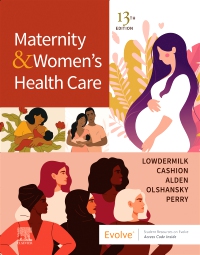
Maternity and Women's Health Care Elsevier eBook on VitalSource, 13th Edition
Elsevier eBook on VitalSource

This bestselling maternity book is now even better! Maternity and Women's Health Care, 13th Edition provides evidence-based coverage of everything students need to know about caring for women of childbearing age. In addition to emphasizing childbearing concerns like newborn care, it also addresses wellness promotion and management of women's health problems. In describing the continuum of care, it integrates the importance of understanding family, culture, and community-based care. New guidelines are incorporated with updated content throughout, focusing on prioritization of care and interprofessional care.
-
- NEW! Case studies and unfolding case studies for the Next Generation NCLEX®.
- NEW! Content on COVID-19 includes current recommendations from professional organizations related to vaccines and the care of pregnant women and newborns.
- UPDATED! Increased coverage of the needs of nontraditional families.
- UPDATED! Coverage of legislative changes that affect health care delivery in the United States.
- UPDATED! Current recommendations and practice changes from professional organizations, such as the American College of Obstetricians and Gynecologists (ACOG), the Association for Women’s Health, Obstetric and Neonatal Nurses (AWHONN), and the American Academy of Pediatrics (AAP).
- UPDATED! Enhanced content on client- and family-centered care focuses on diversity and cultural assessment.
- UPDATED! Added emphasis on racial disparities in relation to women’s health and childbearing.
- UPDATED! Cutting-edge content on treatments for breast cancer.
- Expert authors of the market-leading maternity nursing textbook deliver the most accurate, up-to-date content.
- Signs of Potential Complications highlight vital concerns, alerting students to signs and symptoms of complications and the immediate interventions to provide.
- Cultural Considerations stress the importance of considering the beliefs and health practices of clients and their families from various cultures when providing care.
- Medication Guides provide key information about commonly used medications with specific nursing implications.
- Medication Alerts highlighted and integrated within the content alert readers to critical drug information that must be considered to provide safe client care.
- Safety Alerts highlighted and integrated within the content draw attention to developing competencies related to safe nursing practice.
- Nursing Care Plans identify priority client problems and concerns, along with appropriate interventions and rationales.
- Community Activity boxes focus on maternal and newborn activities that can be pursued in local community settings and online and illustrate nursing care in a variety of settings, including assisting clients in locating resources.
- Emergency boxes provide information about various emergency situations and offer a quick reference in critical situations.
- Teaching for Self-Management boxes highlight important information that nurses need to communicate to clients and families for follow-up care.
-
- NEW! Case studies for the Next Generation NCLEX®.
- NEW! Content on COVID-19 includes current recommendations from professional organizations related to vaccines and the care of pregnant women and newborns.
- UPDATED! Increased coverage of the needs of nontraditional families.
- UPDATED! Coverage of legislative changes that affect health care delivery in the United States.
- UPDATED! Current recommendations and practice changes from professional organizations, such as the American College of Obstetricians and Gynecologists (ACOG), the Association for Women’s Health, Obstetric and Neonatal Nurses (AWHONN), and the American Academy of Pediatrics (AAP).
- UPDATED! Enhanced content on client- and family-centered care focuses on diversity and cultural assessment.
- UPDATED! Added emphasis on racial disparities in relation to women’s health and childbearing.
- UPDATED! Cutting-edge content on treatments for breast cancer.
-
Part 1: Introduction to Maternity and Women’s Health Care
Chapter 1: 21st-Century Maternity and Women’s Health Nursing
Chapter 2: Community Care: The Family and Culture
Chapter 3: Nursing and Genomics
Part 2: Women’s Health
Chapter 4: Assessment and Health Promotion
Chapter 5: Violence Against Women
Chapter 6: Reproductive System Concerns
Chapter 7: Sexually Transmitted and Other Infections
Chapter 8: Contraception and Abortion
Chapter 9: Infertility
Chapter 10: Problems of the Breast
Chapter 11: Structural Disorders and Neoplasms of the Reproductive System
Part 3: Pregnancy
Chapter 12: Conception and Fetal Development
Chapter 13: Anatomy and Physiology of Pregnancy
Chapter 14: Nursing Care of the Family During Pregnancy
Chapter 15: Maternal Nutrition
Part 4: Labor and Birth
Chapter 16: Labor and Birth Processes
Chapter 17: Maximizing Comfort for the Laboring Person
Chapter 18: Fetal Assessment During Labor
Chapter 19: Nursing Care of the Family During Labor and Birth
Part 5: Postpartum
Chapter 20: Postpartum Anatomical and Physiologic Changes
Chapter 21: Nursing Care of the Family During the Postpartum Period
Chapter 22: Transition to Parenthood
Part 6: The Newborn
Chapter 23: Physiologic and Behavioral Adaptations of the Newborn
Chapter 24: Nursing Care of the Newborn and Family
Chapter 25: Newborn Nutrition and Feeding
Part 7: Complications of Pregnancy
Chapter 26: Assessment of High-Risk Pregnancy
Chapter 27: Hypertensive Disorders
Chapter 28: Hemorrhagic Disorders
Chapter 29: Endocrine and Metabolic Disorders
Chapter 30: Medical-Surgical Disorders
Chapter 31: Mental Health Disorders and Substance Abuse
Chapter 32: Labor and Birth at Risk
Chapter 33: Postpartum Complications
Part 8: Newborn Complications
Chapter 34: Nursing Care of the High-Risk Newborn
Chapter 35: Acquired Problems of the Newborn
Chapter 36: Hemolytic Disorders and Congenital Anomalies
Chapter 37: Perinatal Loss, Bereavement, and Grief







 as described in our
as described in our 